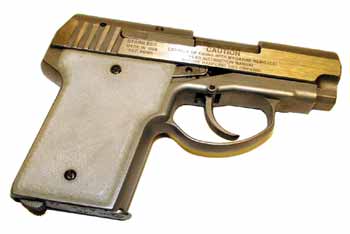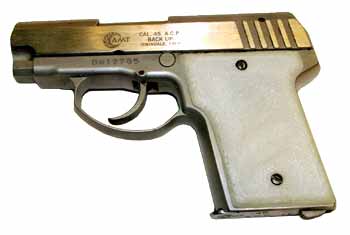|
|
|
AMT 45 Backup Check. (117d)
|
| |

|
Quantity in Basket:
None
Code: AMT_117d
Price: $68.00
Shipping Weight: 0.20 pounds
|
| |


This is a checkered grip. It may look smooth in the images,
but that is because the checkering is very closely spaced.
It doesn't look as good in pearl as a smooth version. If you
want pearl, and want a smooth version, do NOT order this
particular grip! It is an exact copy of the factory grip
with fine checkering.
The AMT (Arcadia Machine & Tool) .45 Backup uses very
thin grips with flat backs, secured by two short screws
per panel (which are not furnished by Tombstone but come
with the gun, and may be ordered from High Standard at
this time). In order to make the gun work with the new
grips, you will need to use a Dremel or other rotary bit
tool and lightly relieve a depression in the right hand
grip, back side, just over the area where the trigger
return spring and linkage sits. You can tell when you
have enough area and depth removed because the trigger
will reliably reset. If you don't have enough of a
depression to clear the little hairpin spring, the trigger
can be pulled but it won't come back to ready position
again. This is easy to do but take it slow because the
grips are thin, and don't require much of a depression.
Another thing to look at is the hole depth versus grip
thickness. The little screws that come with the gun are
very short. You may need to stretch a piece of 320 grit
abrasive paper on a flat piece of wood (tape or glue it
down) and rub the back of the grip over this by moving
the grip in circles, to reduce the thickness just enough
so a few threads of the screw engage the hole in the frame.
It may not be necessary, but keep this in mind in case
the screws don't seem to reach the holes!
Grip Dimensions:
- Hole Centers = 2.15 inches
- Overall height = 2.9 inches
- Width across base = 1.67 inches
- Width across top = 2.18 inches
- Approximate grip thickness = 0.15 inches
A final point is that the hole position might vary just
a tad. The precision of the gun is usually good, but... all
it takes is a very slight tolerance in the hole position,
and the grip screw holes might not quite align. With a
longer screw and thicker grip, this wouldn't cause a
problem because there would be enough leverage to get a
thread or two engaged and then torque the grip into
alignment, but these tiny, short screws have to be right
on...you don't want to reef on them or you'll damage the
end threads. Therefore, if you get one screw in the grip
and can see that the other hole is even slightly off, remove
the grip and use a small round file to gently elongate
the holes, with half the distance required in each hole, so that the screw
will be able to go in straight. The amount of oval that
would be required is so small that it won't hurt a thing,
but it can make installation a great deal quicker and
easier, and save the starting threads on your screws.



 On a personal note: Shooting the AMT 45 Backup can be done with more
accuracy if you practice bringing the 10-12 pound trigger pull just short of
firing, and find a sort of "plateau" in the pull, just before the hammer releases. It isn't
difficult to keep the sights in the target zone if you are not fighting that hard pull at the same
time. I found it was a reasonably accurate gun for its size, once I taught myself to
aim and bring the heavy trigger to a point where it was easy to hold, then refine the aim while
gently increasing the pressure until the hammer falls. This sort of artificially created "two-stage"
trigger pull is somewhat tiring, so I limit my practice sessions to not more than 25 or 30 rounds
at a time.
On a personal note: Shooting the AMT 45 Backup can be done with more
accuracy if you practice bringing the 10-12 pound trigger pull just short of
firing, and find a sort of "plateau" in the pull, just before the hammer releases. It isn't
difficult to keep the sights in the target zone if you are not fighting that hard pull at the same
time. I found it was a reasonably accurate gun for its size, once I taught myself to
aim and bring the heavy trigger to a point where it was easy to hold, then refine the aim while
gently increasing the pressure until the hammer falls. This sort of artificially created "two-stage"
trigger pull is somewhat tiring, so I limit my practice sessions to not more than 25 or 30 rounds
at a time.
Some shooters have told me that the .45 Backup is just too
hard to shoot because of the recoil, but it is a fairly heavy pistol. I can't
agree with that assessment: for me, the recoil is just what you might expect
from the .45 ACP in any moderately small handgun -- stiff but not painful or hard
to control.
If you think a 10-12 pound trigger pull is too heavy, you
would be right except that once you get it pulled back to
that staging point, it only takes a minor amount of additional
effort to coax the release. It's almost as if the sear is
acting like a "set trigger", even though getting it set may
jerk the point of aim around somewhat. My wife, who has a hard
time pulling the slide back on a Sig 220 or most other
centerfire autos, has no problem at all with the trigger
pull on the AMT...and she likes the .45 ACP in almost any
gun. Consider that the gun has no other safety. You
carry it with a round in the chamber. With a hammer, not
a striker, the only way to make the firing pin hit the
primer is to cock the hammer spring and then let the
hammer fall. With a DAO pistol, that's what the long
hard trigger pull does. It is, in fact, the safety.
This gun will fire with the magazine removed, so it is
very important to cycle the slide any time the magazine
is removed, extracting the round in the chamber. If you just
assume there is ALWAYS a round in the chamber, unless
you are looking through the chamber and seeing daylight
from the muzzle, then this is a very safe gun for someone
who hasn't much time for practice. No controls to worry
about. Just aim and pull, hold, refine the aim, and finish
pulling. I wouldn't recommend it over a full size gun or
a revolver, if space wasn't an issue. But for a compact
if somewhat heavy defense pistol, it works.
Of course, I don't shoot rapid fire bullseye matches with the gun!
But outside of the longer time to get back on target and the hard pull to operate
the double-action-only mechanism, I wouldn't be worried about anything except
running out of time and only getting four shots in the black. I have no doubt
that in slow-fire, with plenty of time for nursing that second stage of the trigger release, the scores wouldn't
be any more embarrassing than my usual shooting!
However, I did find that handloads can be problematic with
the little pistol. Some of my target loads, which work fine in
a number of full-size 1911 pistols or 1955 S&W .45 ACP revolvers,
jammed the little gun by not quite chambering. The gun was
difficult for me to clear, and couldn't be taken apart to clear because
the slide had to be retracted to bring it into a take-down
position. The slide wouldn't budge. I finally took a chance, kept it
pointed downrange, and tapped the rear of the slide with a
plastic mallet to force it closed, then fired the "stuck" round
to clear it. The problem is that the case wasn't properly
full-length sized. I also had trouble with soft point bullets feeding
into the top of the barrel and distorting, then stopping the
gun. But in spite of those issues, the gun has always been
reliable with FMJ government or factory ammo, or with handloads that
are full length sized and loaded with a bullet having the same
profile as the GI round, without too much exposed lead at the tip.
I'd feel comfortable relying on it to work with standard FMJ factory
loads or the equivalent.
|
Related Item(s)
|
Code
|
Name
|
Price
|
Availability
|
|
|
AMT_4c
|
AMT .380 Backup Check. (4c)
|
$68.00
|
|
|
AMT_4d
|
AMT .380 Backup smooth (4d)
|
$68.00
|
|
|
AMT_104b
|
AMT 45 Backup, contoured (104b)
|
$68.00
|
|
|
AMT_104e
|
AMT 45 Backup, smooth, thin (104e)
|
$68.00
|
|
|













On a personal note: Shooting the AMT 45 Backup can be done with more accuracy if you practice bringing the 10-12 pound trigger pull just short of firing, and find a sort of "plateau" in the pull, just before the hammer releases. It isn't difficult to keep the sights in the target zone if you are not fighting that hard pull at the same time. I found it was a reasonably accurate gun for its size, once I taught myself to aim and bring the heavy trigger to a point where it was easy to hold, then refine the aim while gently increasing the pressure until the hammer falls. This sort of artificially created "two-stage" trigger pull is somewhat tiring, so I limit my practice sessions to not more than 25 or 30 rounds at a time.

















































